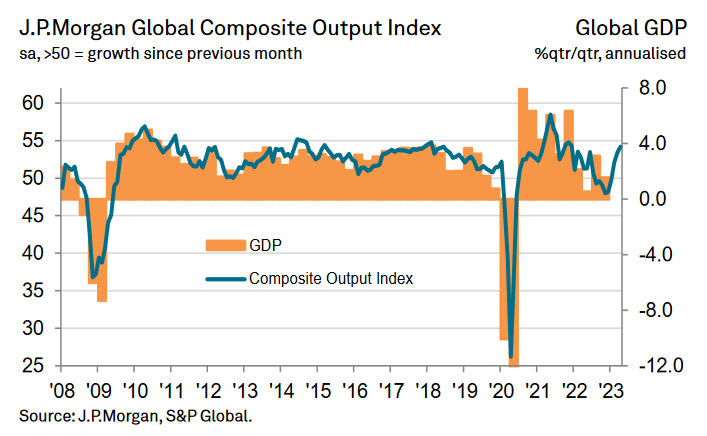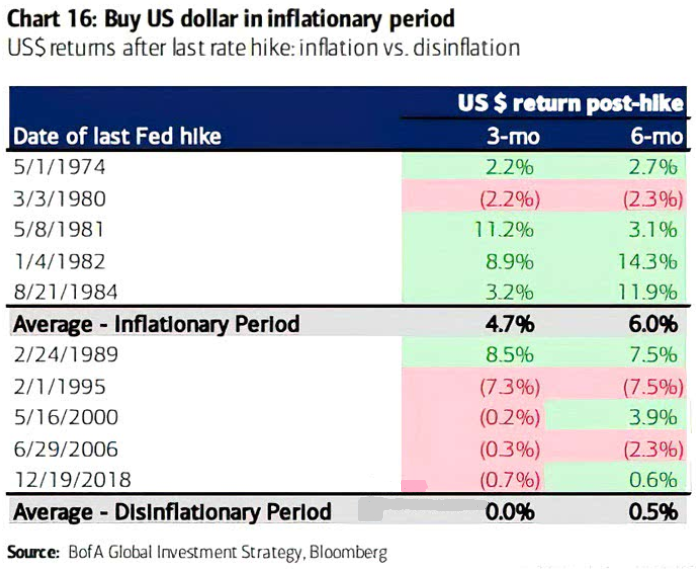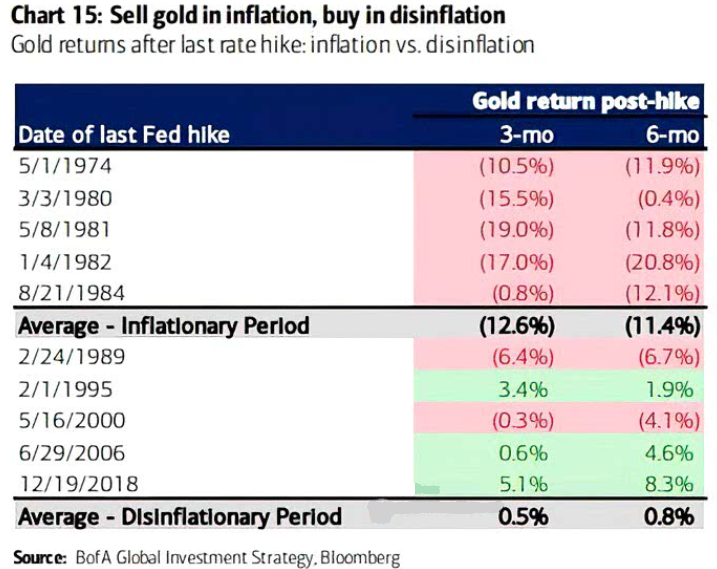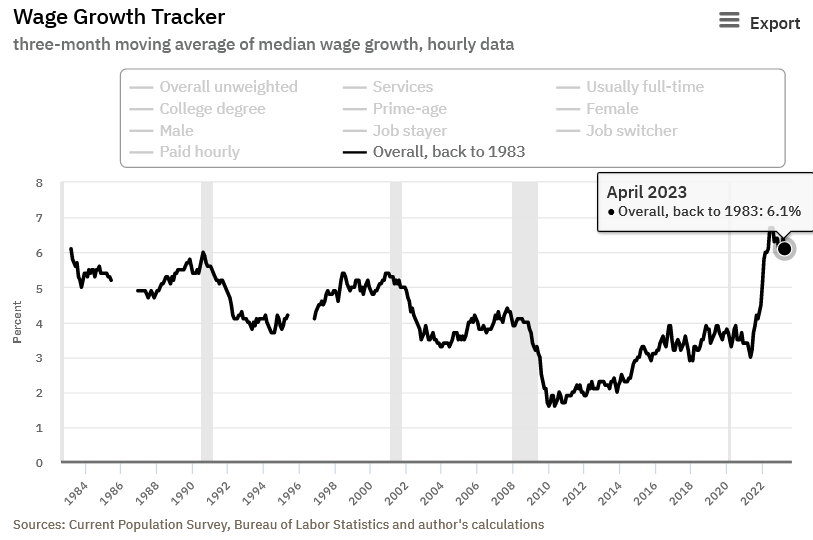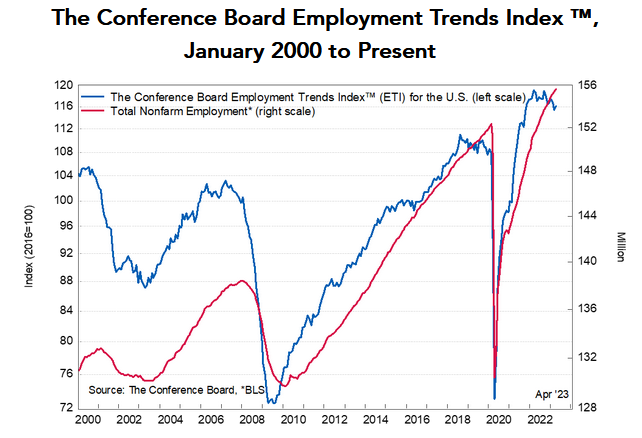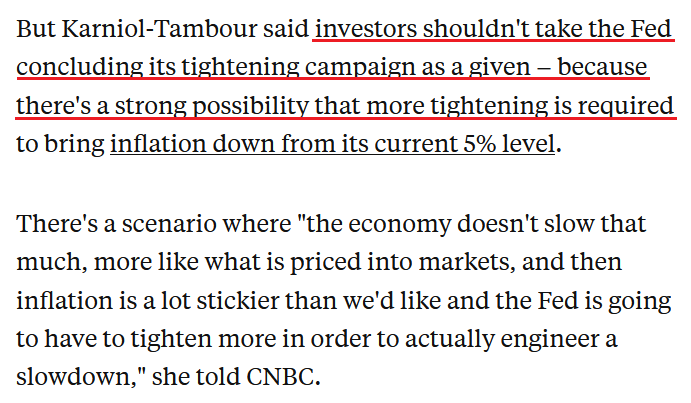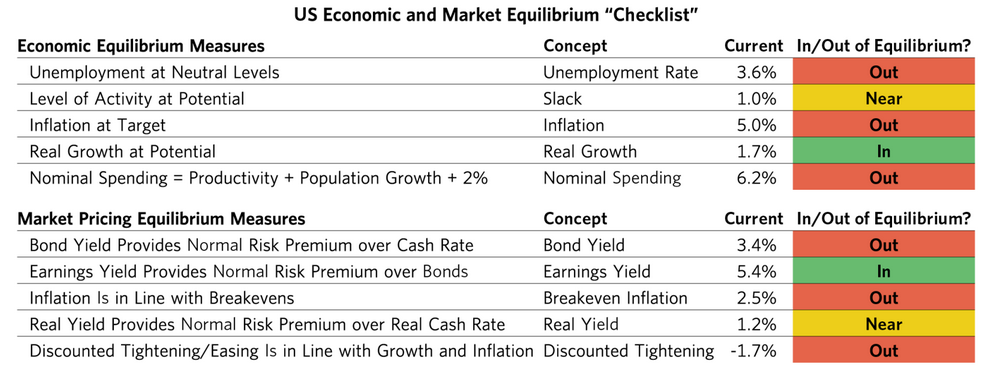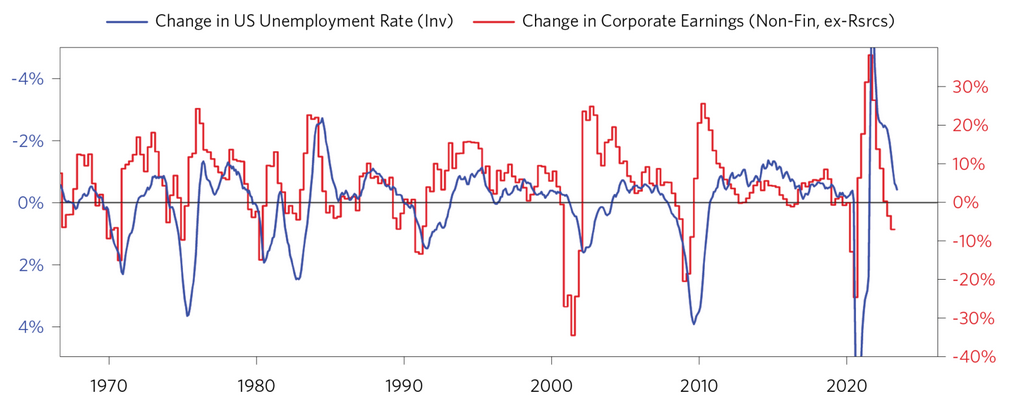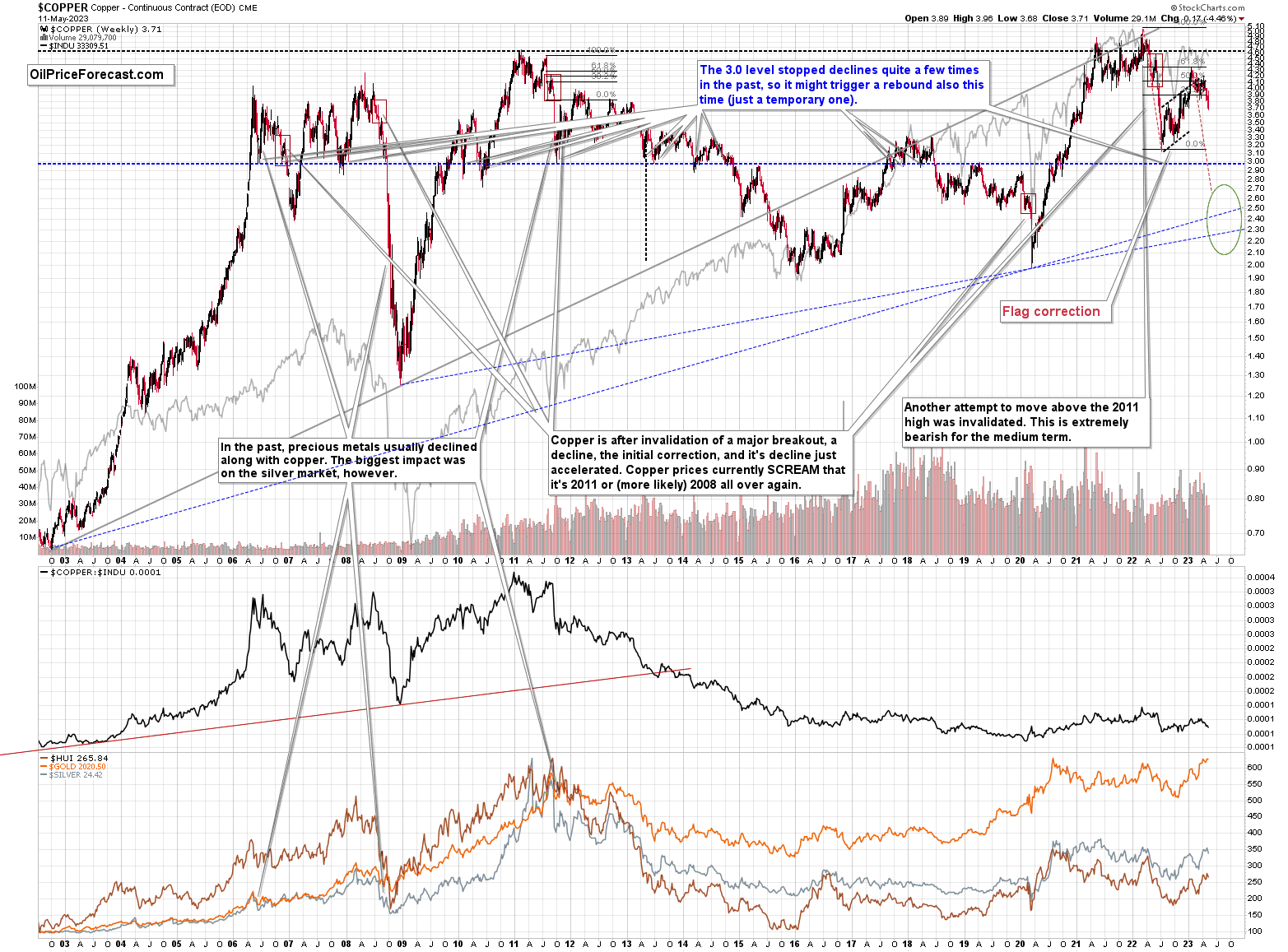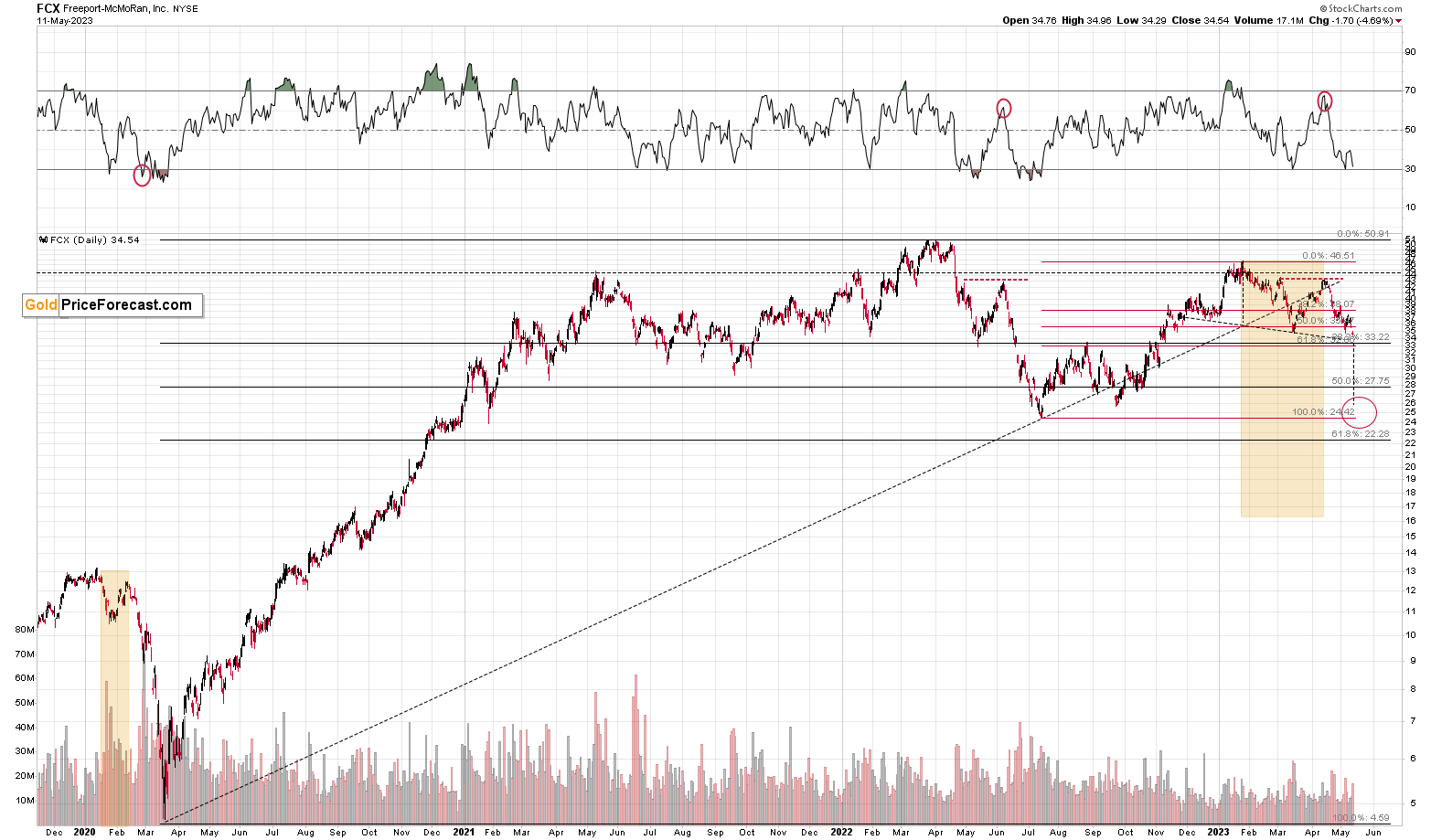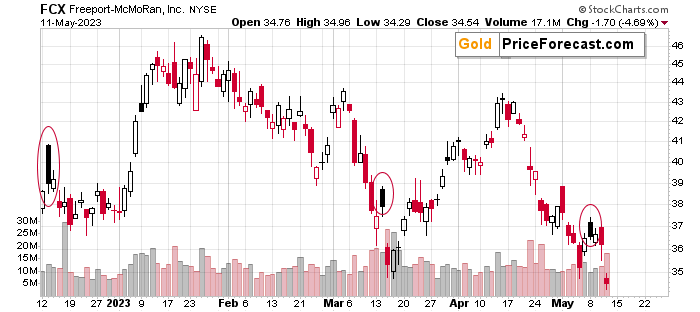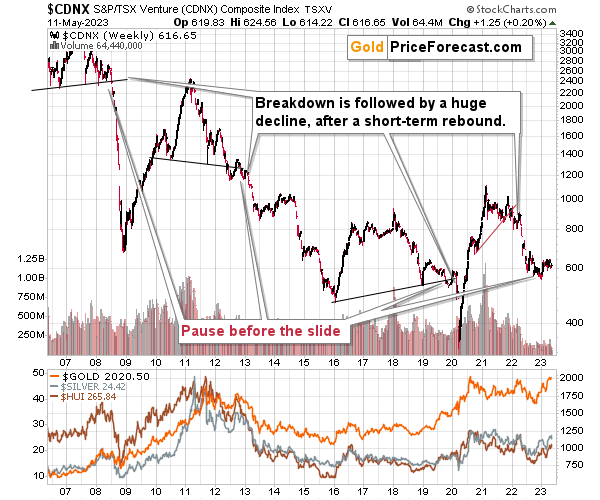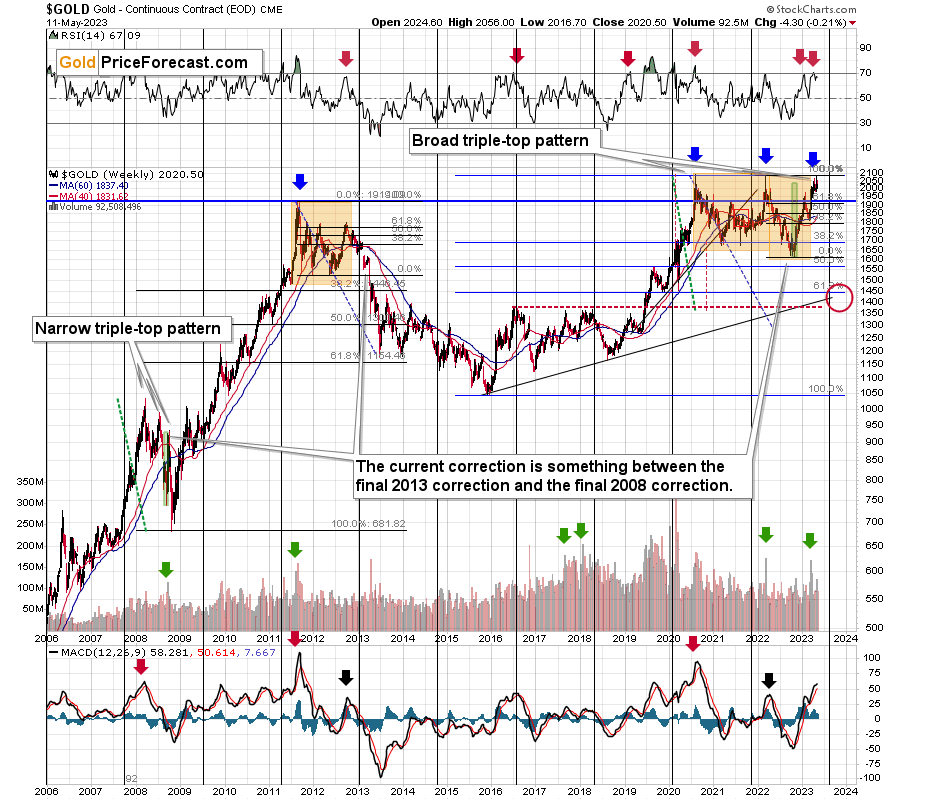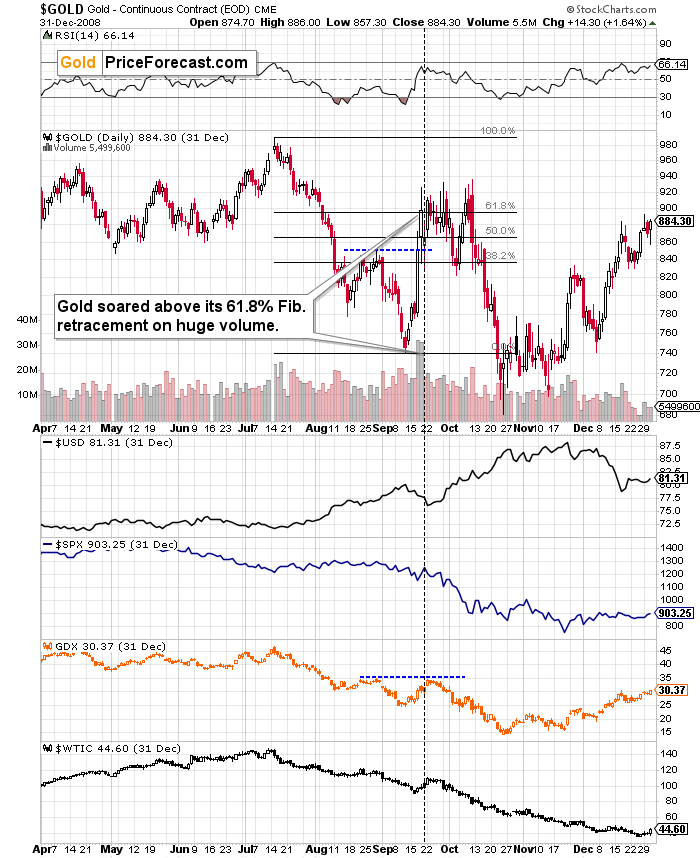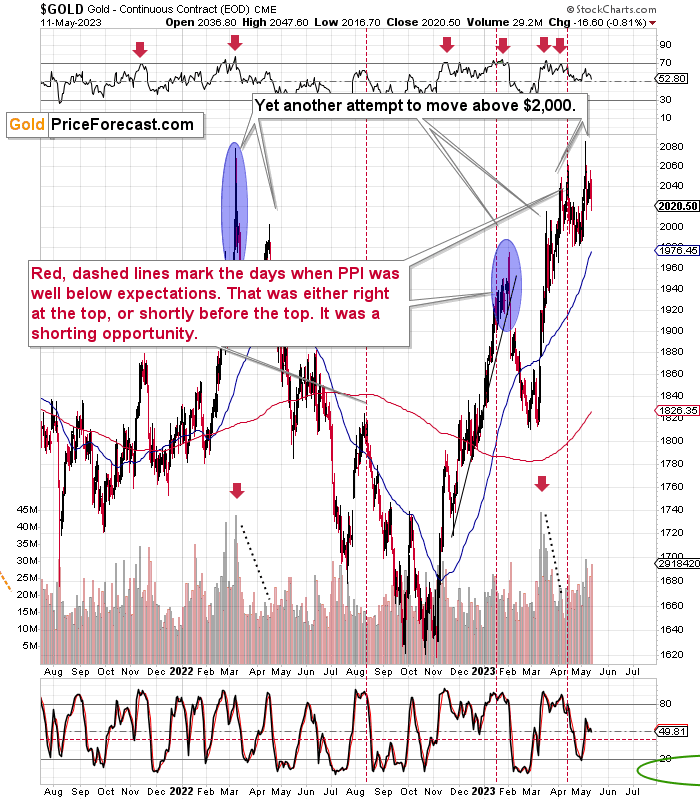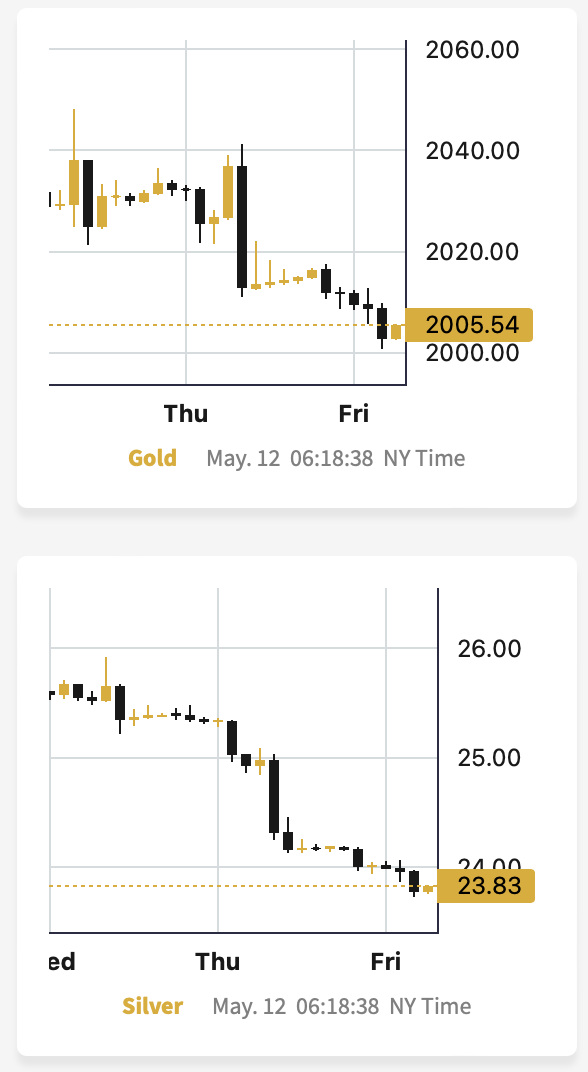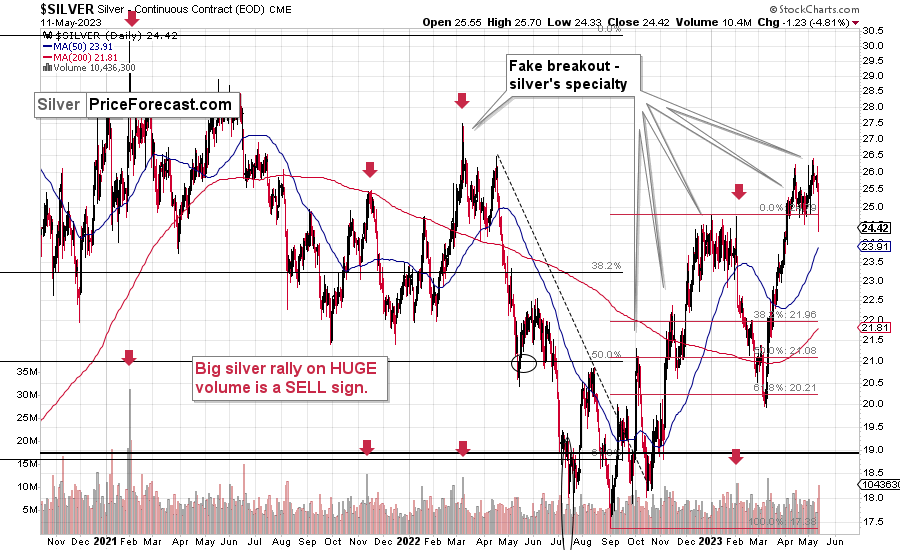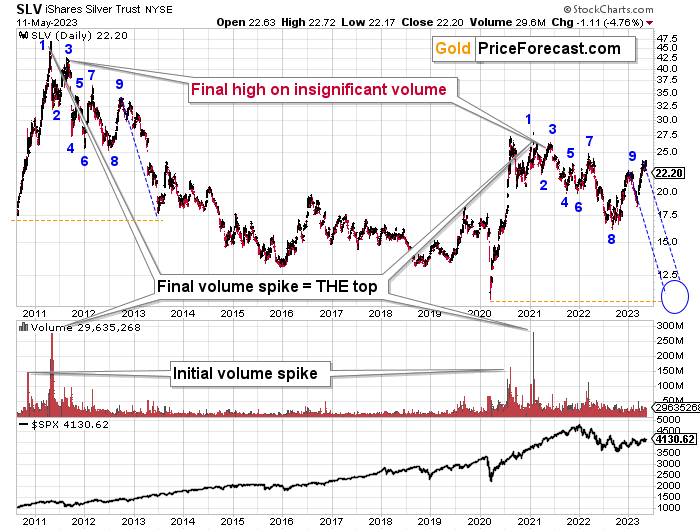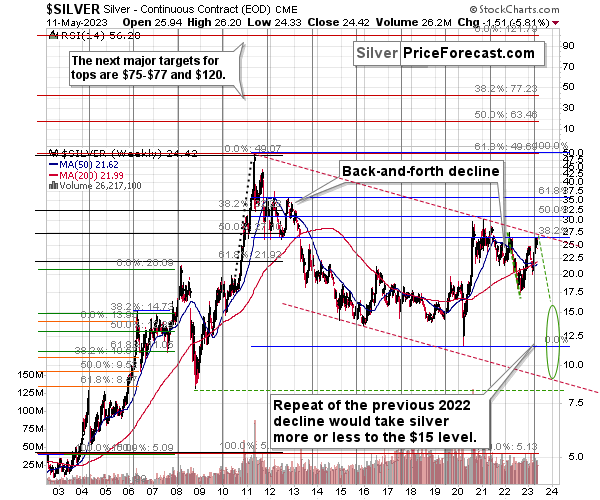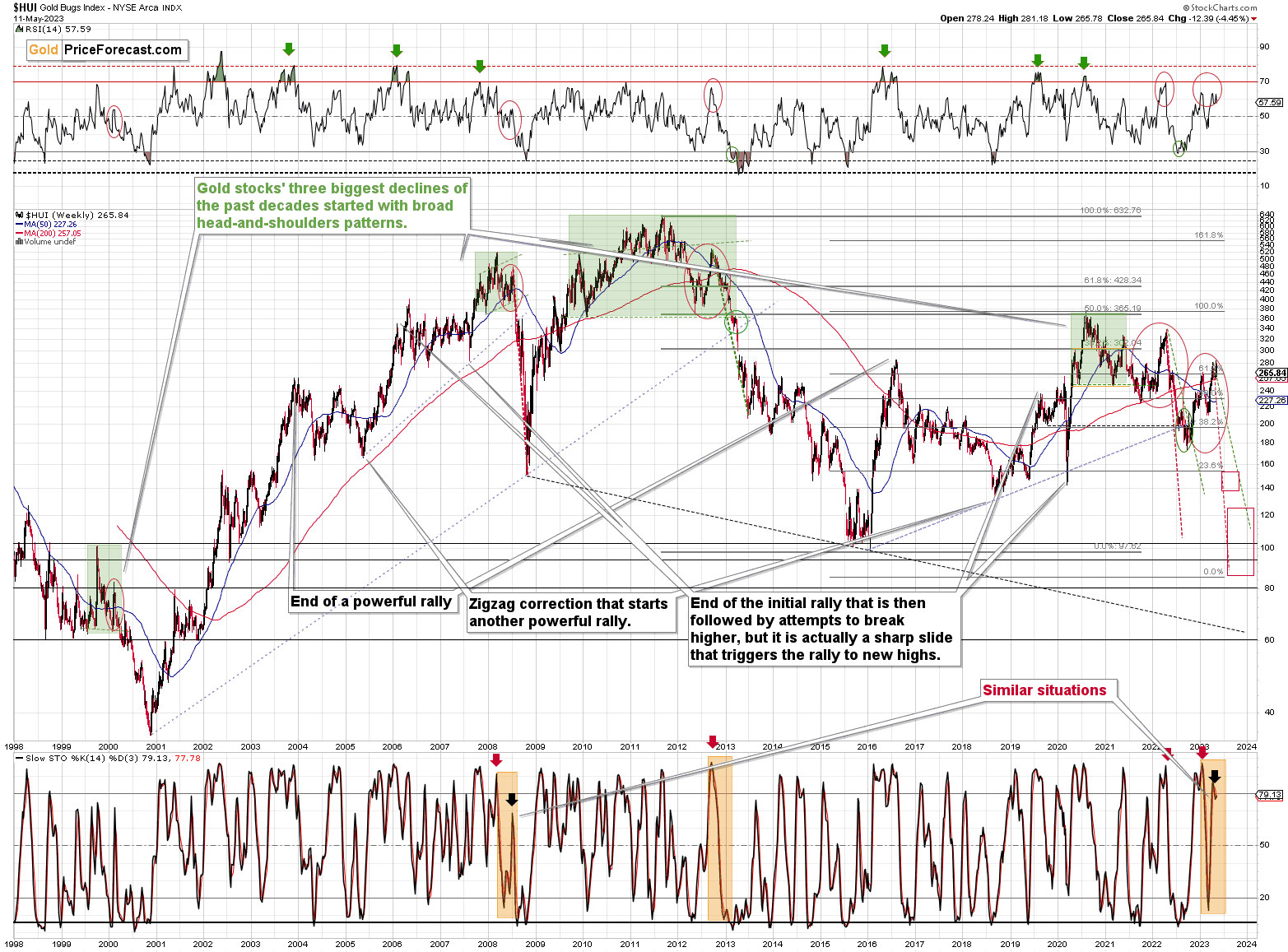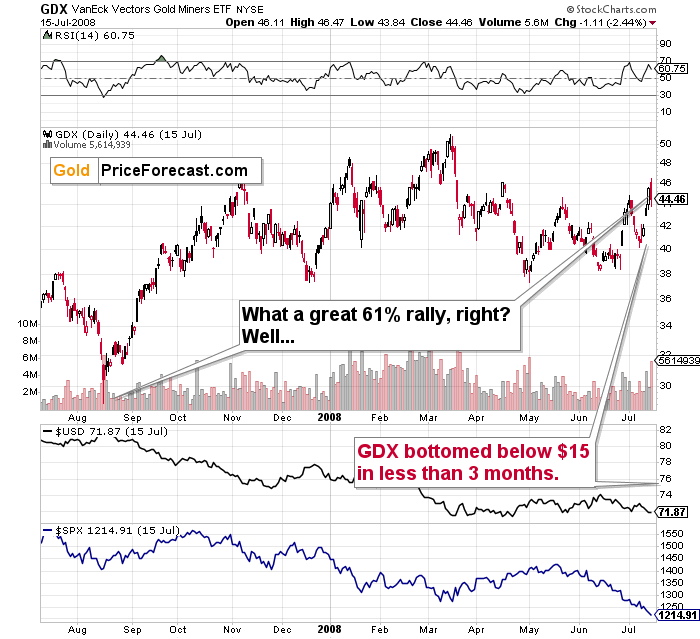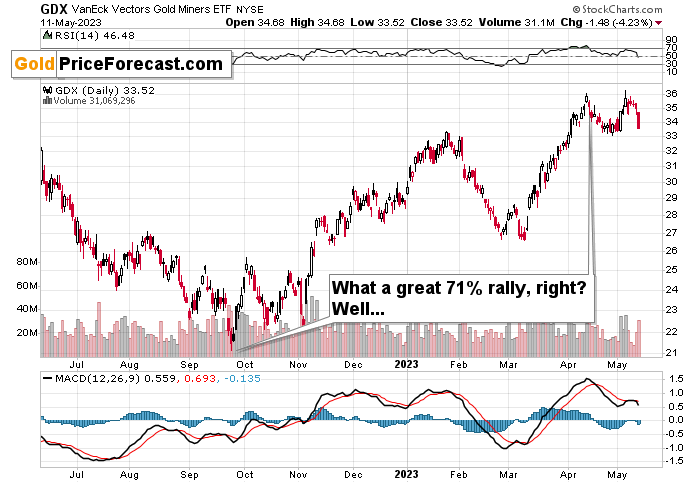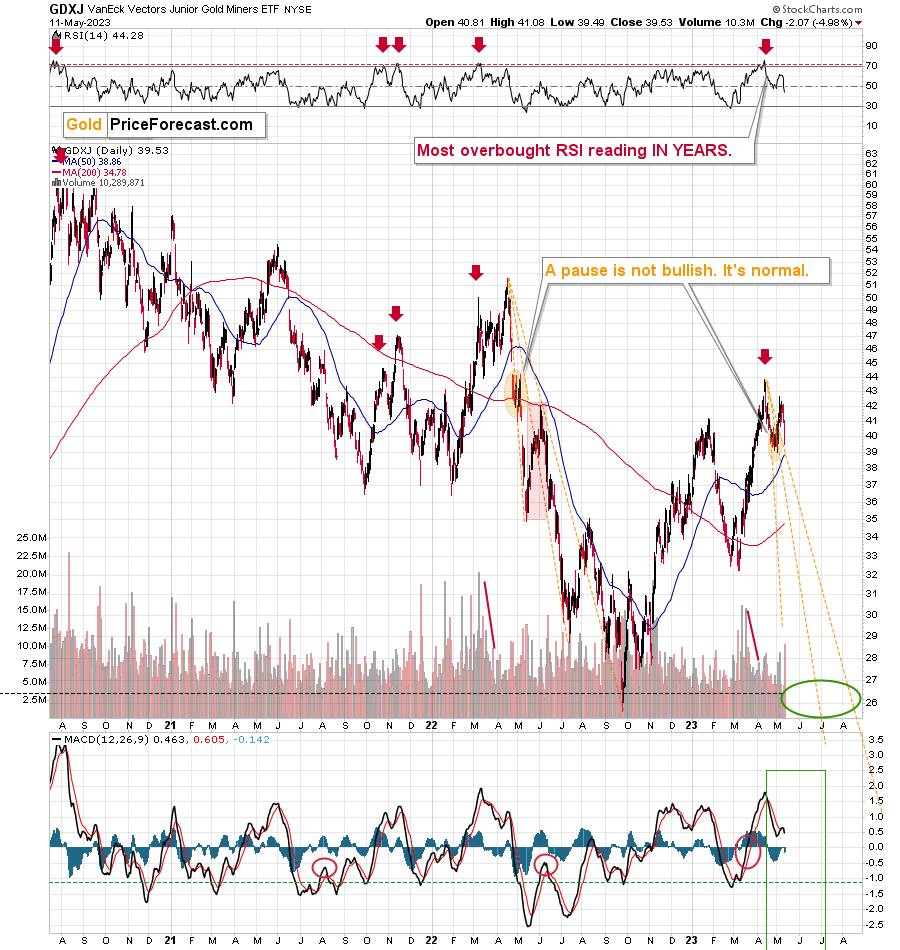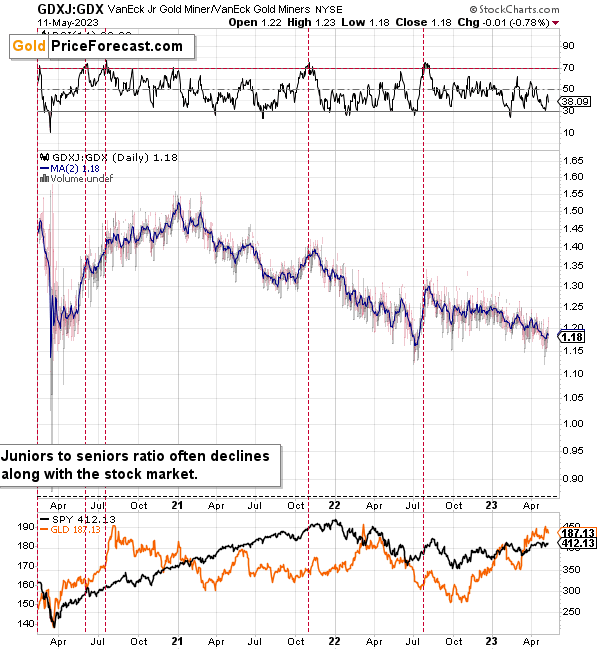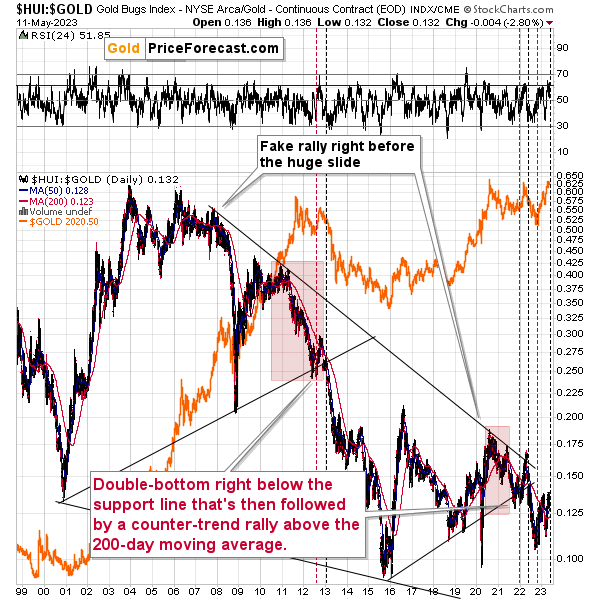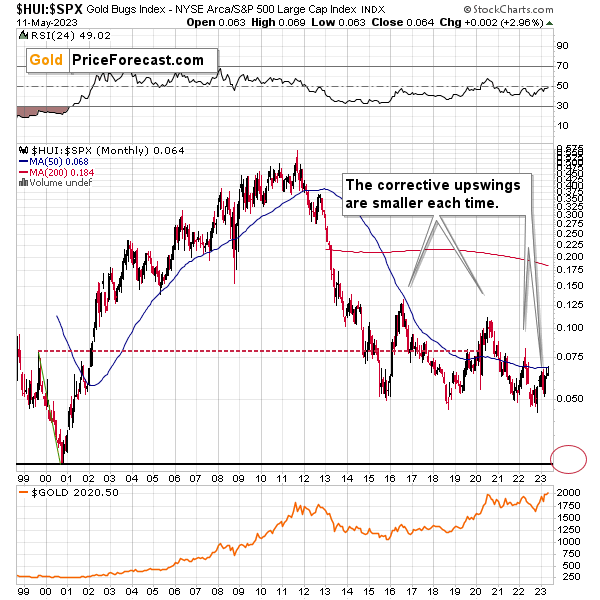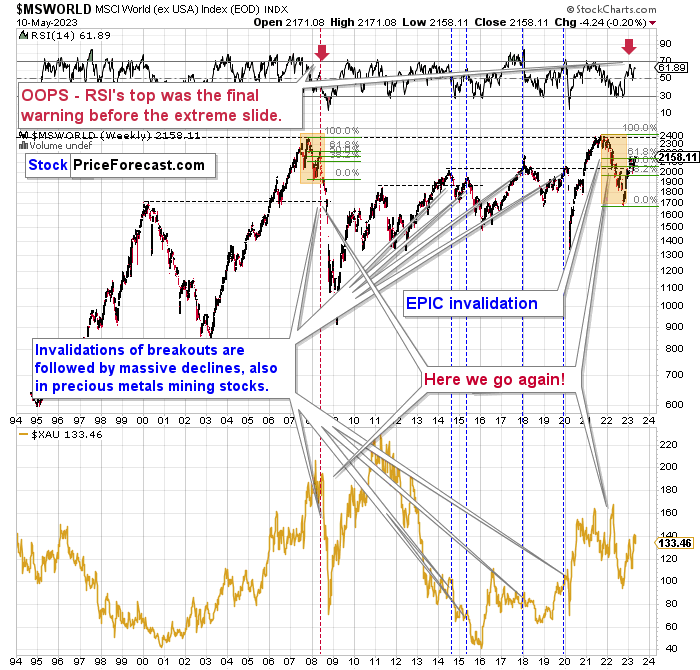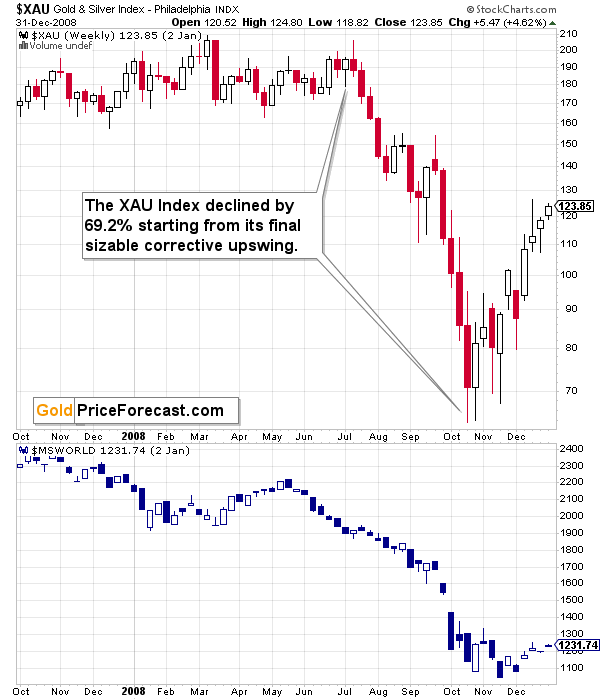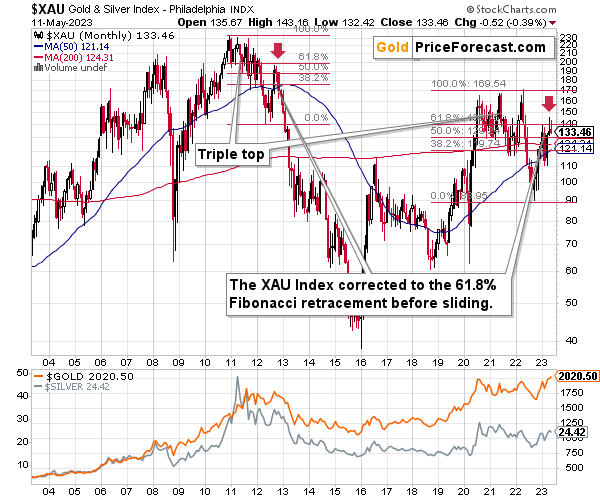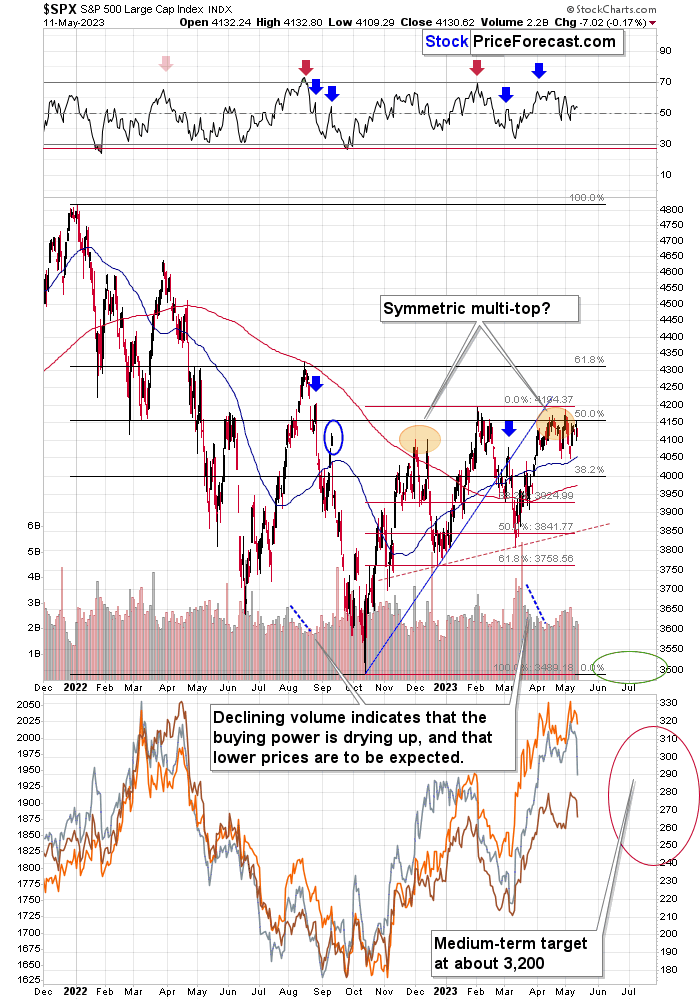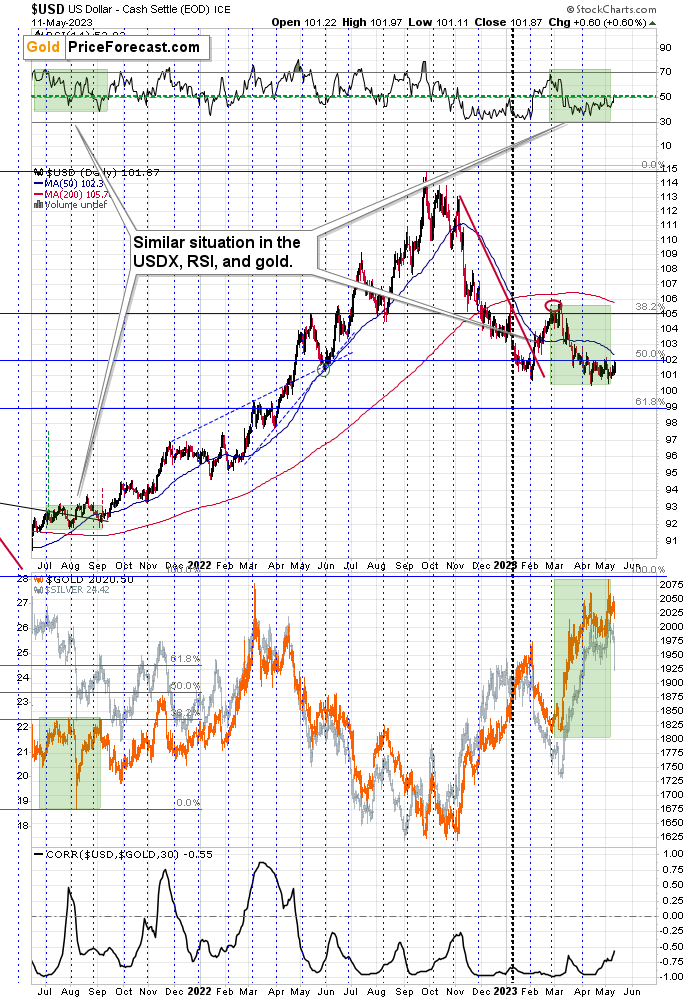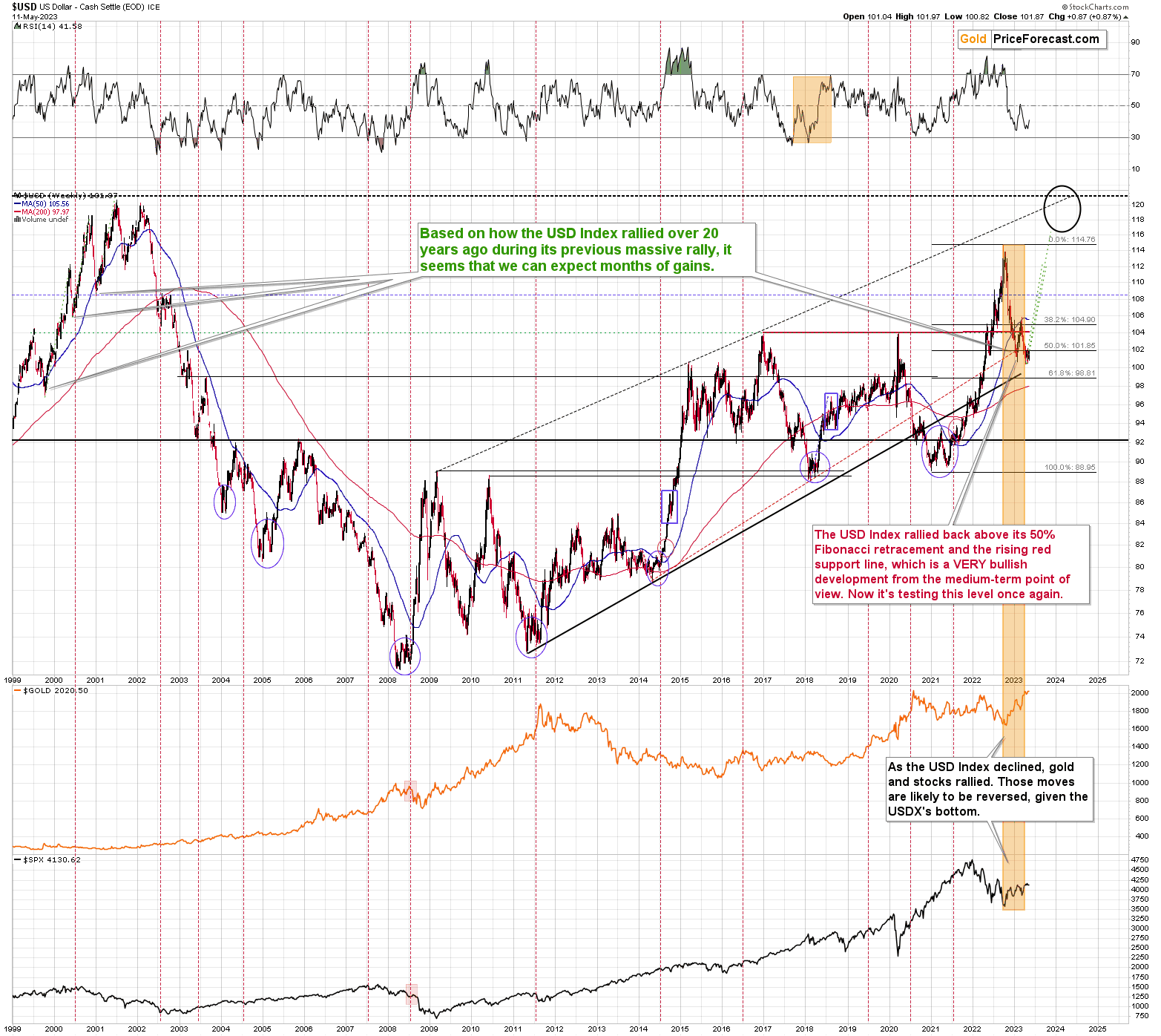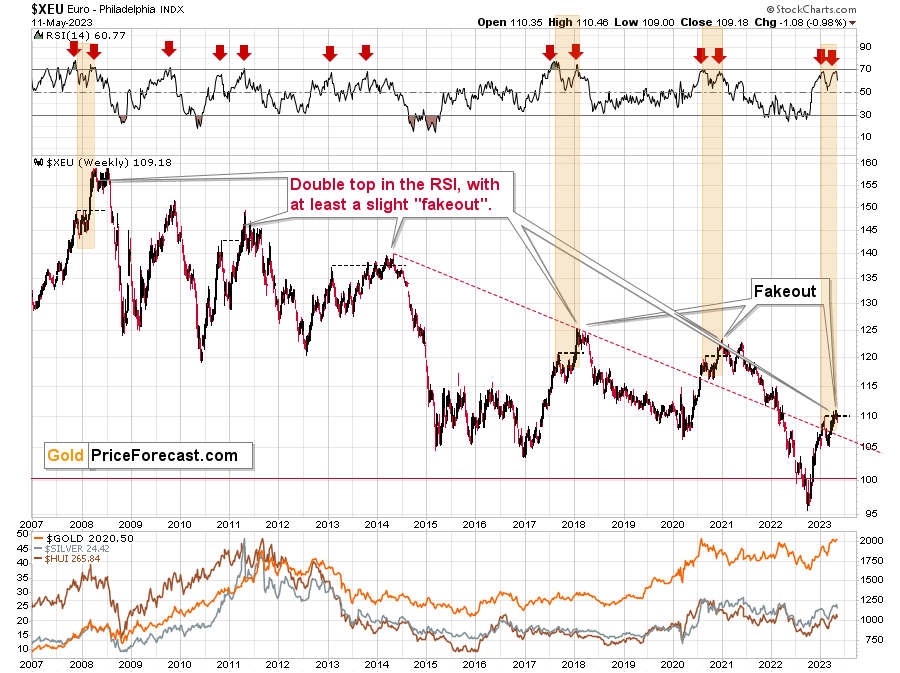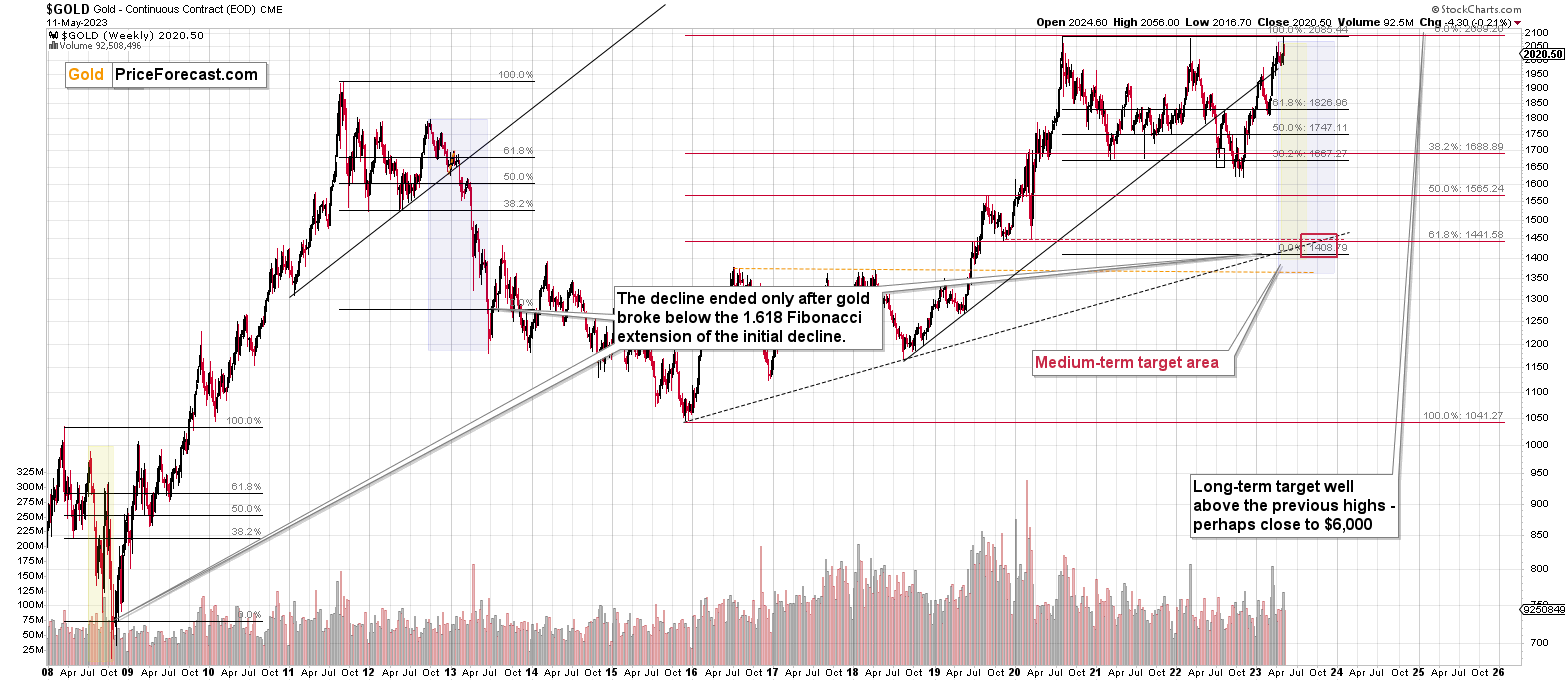Briefly: gold and the rest of the precious metals market are likely to decline in the next several weeks/months and then start another powerful rally. Gold’s strong bullish reversal/rally despite the USD Index’s continuous strength will likely be the signal confirming that the bottom is in.
Welcome to this week's Gold Investment Update. Predicated on last week’s price moves, our most recently featured outlook remains the same as the price moves align with our expectations. On that account, there are parts of the previous analysis that didn’t change at all in the earlier days, which will be written in italics.
The key thing that’s most important from our point of view that happened this week is another rapid decline in the FCX (to new yearly lows!) that translated into rapid growth of profits in our short position in it. FCX is down by over 5% this week, and the week is not even over.
Taking positions aside, the key thing that happened is gold’s another weekly (almost) reversal that strengthened (even more!) the bearish implications of last week’s reversal and silver’s move back below its early-2023 highs. This is all very bearish, and it suggests that we won’t have to wait too long for the GDXJ to join FCX in the profitable status.
Quite many things happened on the fundamental front as well, so I’ll take this opportunity to update you on those changes first, and I’ll move to the technicals next.
The Weekly Fundamental Roundup
The headline Consumer Price Index (CPI) continued its year-over-year (YoY) decent this week, as base effects remain the primary driver. However, those benefits end in June, and month-over-month (MoM) prints of 0.40% will look much more problematic when the index recalibrates.
Likewise, the U.S. labor market remains resilient, and wage pressures are abundant. As a result, while the crowd assumes that inflation is old news, its durability is still underappreciated.
The Narratives Driving Gold
With silver and mining stocks declining sharply on May 11, the PMs' volatility was on full display. And while base effects provide the trio with inflation cover through June, the second half of 2023 should elicit more economic anxiety.
For example, New York Fed President John Williams upped the hawkish ante on May 9. He said:
“In my forecast I see a need to keep a restrictive stance of policy in place for quite some time to make sure we really bring inflation down from 4% all the way to 2%. I do not see in my baseline forecast any reason to cut interest rates this year.”
So, while the PMs have benefitted from rate-cut prophecies, QE dreams, bank contagion fears, and the prospect of a depressed U.S. dollar, these narratives contrast the realities that should unfold in the months ahead.
Williams added:
Thus, while the crowd assumes that zero-interest-rate (ZIRP) policy is next, we warned throughout 2021, 2022, and recently, that those bets are increasingly premature.
As evidence, S&P Global and J.P. Morgan released their Global Composite PMI on May 5. The headline index increased from 53.4 in March to 54.4 in April, reaching a 16-month high. The report stated:
“The start of the second quarter saw a further acceleration in the rate of global economic expansion. Growth of output and new orders hit their highest levels since December 2021 and March 2022 respectively, as job creation and business optimism also strengthened….
“All of the 14 nations for which April composite PMI data were available registered an expansion of combined manufacturing and service sector output, the first time concurrent growth has been recorded since June 2022.”
Please see below:
To explain, the blue line above tracks the Global Composite PMI, while the orange bars above track annualized global GDP growth. If you analyze the relationship, you can see that the former often leads the latter.
More importantly, the right side of the chart shows how the blue line’s ascent signals resilient GDP growth in the months ahead. As such, a PMI of ~54 is nothing like 2008 or 2020, and this is why talk of lower interest rates is much more semblance than substance.
A History Lesson
While the crowd assumes a dying U.S. dollar will help revive gold, it’s another narrative that contrasts history.
Please see below:
To explain, Bank of America compiled a performance table for the USD Index three and six months after the Fed’s final rate hike. If you analyze the top half, you can see that during four of the five inflationary periods, the dollar basket strengthened over the next three and six months.
Now, we don’t believe the Fed has completed its rate-hike cycle, but the data highlights how a pause is not bearish for the USD Index. Therefore, while realities of sticky inflation and resilient demand should surprise the crowd over the medium term, even the pause bulls are fighting history.
To that point, Bank of America compiled a similar performance table for gold.
Please see below:
To explain, the figures at the top half show how after the Fed’s last rate hike during the inflationary periods of the 1970s/1980s, gold weakened over the following three and six months. Again, we believe the Fed’s rate-hike cycle has more room to run. However, even if 5.25% is the peak, the medium-term outlook for the USD Index is bullish, while the medium-term outlook for gold is bearish.
Finally, while the Atlanta Fed’s Wage Growth Tracker dipped in April, it’s only 0.6% below the record high set in 2022. Moreover, if we exclude the post-pandemic period, 6.1% would be an all-time high dating back to 1983.
Please see below:
Likewise, The Conference Board released its Employment Trends Index (ETI) on May 8. The metric increased from 115.51 in March (a downward revision) to 116.18 in April. Frank Steemers, Senior Economist at The Conference Board, said:
“The labor market remains resilient and tighter than before the pandemic, complicating the Federal Reserve’s efforts to slow inflation. This may prompt the Fed to raise interest rates by an additional 25 basis points to decelerate job growth and wage gains.”
Thus, while Steemers expects “a short and mild recession starting in 2023,” he conceded that “it may take until later in the year to see substantial weakening in job growth, or monthly job losses.”
Consequently, while the recession bulls continue to forecast doom, non-compliant data keeps pushing those expectations further into the future. And this was the story throughout late 2021 and 2022.
Please see below:
Like the Atlanta Fed’s Wage Growth Tracker, the ETI has come down from its recent peak. However, the progress has been relatively mild, which highlights why interest rates are too low to create lasting disinflation.
Overall, short-term sentiment helped gold, silver and mining stocks, as bullish narratives distracted the crowd from the fundamental realities. But, data-driven analysis does not support these consensus conclusions, and we believe the PMs are vastly mispriced. As a result, more meltdowns like the one on May 11 should unfold in the months ahead.
Should you sell gold after the Fed’s last rate hike, or is this time different?
A Minsky Moment Strikes Silver
With silver plunging by nearly 5% on May 11, its descent highlights the dangers of momentum investing. Moreover, we warned on May 5 that one-sided positioning often elicits a race for the exits. We wrote:
Rate cuts and QE are illogical when the PMIs, inflation, and employment are accelerating. Therefore, it’s likely only a matter of time before a Minsky Moment strikes the precious metals market.
So, while we may be approaching a turning point, the silver price needs to decline substantially to reflect its fundamental value. Thus, more weakness should be on the horizon.
Speaking of which, we have been consistent in our thesis that interest rates are too low to suppress demand and cure inflation. And while the crowd disagrees, the Fed should have to remain hawkish for longer than expected, as it did in 2021 and 2022.
Furthermore, Bridgewater Associates' co-CIO Karen Karniol-Tambour expects a similar outcome. For context, Bridgewater Associates is the largest hedge fund in the world. She said on May 3:
“My view is that the economy needs to slow. I don't know if the tightening the Fed has done is enough to slow the economy sufficiently to really bring inflation back down to what its target is…. It's one of the most dangerous and bad times for risk assets that we've seen in decades.”
Consequently, while the crowd assumes QE is a done deal, Karniol-Tambour does not share their enthusiasm.
Please see below:
To that point, Bridgewater Associates’ CIOs explained why on Apr. 14. They wrote:
“The greatest disruption of equilibrium today remains the high level of nominal spending, which, when compared to the ability of the economy to produce more, leads to inflation rates that are significantly above target....
“We are now in the bearish disequilibrium. The following table summarizes a few key measures for the U.S. economy. With respect to the economy, the inflation rate is too high, the rate of nominal spending is too high to bring that down, the rate of unemployment is too low to bring wages down….
“Bond yields are too low in relation to cash and discounted inflation rates are well below current and projected inflation rates, so there is no risk premium in bonds…. At the same time, nominal spending is too high and the labor markets are too tight to allow for the easing of policy that is priced into the front of the yield curve, which is the easing that would be necessary to provide for a normal risk premium in bonds.”
Please see below:
To explain, when nominal spending, inflation and employment are out of whack with economic normality (bearish disequilibrium), bond yields need to rise to create the demand destruction necessary to suppress inflation. And the shaded red areas above show how nominal bonds suffer during these periods.
Conversely, the crowd is pricing in rate cuts. And while this helps uplift the PMs, the optimism contrasts fundamental reality. Likewise, Bridgewater Associates highlights how most of its economic and market-pricing metrics remain in bearish disequilibrium (the shaded red areas).
Please see below:
How Do We Achieve Equilibrium?
To rid the U.S. economy of its inflation problem, achieve the rate-cuts/QE priced in by investors, and end the PMs’ rolling bear markets, wages and consumer spending need to decline materially, which is not happening right now. The CIOs continued:
“Nominal spending, fueled by the wages that consumers earn, is running close to 8%, above the roughly 5% in the recent decades of subdued inflation…. The spread between nominal spending and wages is a good proxy for economy-wide corporate profits, and that positive spread incentivizes hiring and additional wage pressure….
“We estimate corporate profits need to fall roughly 20% and are currently down a bit less than 10%. More pain is needed to raise unemployment, reduce wages, and moderate inflation.”
Please see below:
To explain, the red line above tracks the percentage change in U.S. corporate earnings (excluding financials and resources), while the blue line above tracks the inverted (down means up) percentage change in the U.S. unemployment rate.
If you analyze the relationship, you can see that ~20% declines in corporate earnings have often been required to induce layoffs, raise the unemployment rate (falling blue line), moderate wage inflation and eradicate output inflation. Yet, we are far from this level of demand destruction, and the PMs have benefitted from the fundamental naivety.
Overall, while the permabulls remain highly confident, you can’t run from reality. And if growth, employment and inflation don’t slow fast enough, interest rates will need to rise, which is bullish for the USD Index and bearish for the PMs. As such, we expect these issues to haunt the paper silver price in the months ahead.
Do you agree or disagree with Bridgewater Associates’ conclusions?
The Bottom Line
While sentiment can keep asset prices elevated in the short term, eventually, the fundamentals need to comply. And with the technicals already highly bearish, the consensus has gone all in on the PMs with faulty assumptions. Moreover, with the USD Index suffering from these uninformed narratives, the last few months have created the perfect backdrop for the PMs to shine. However, the environment should shift dramatically over the medium term, and a major recalibration should unfold when reality returns.
In conclusion, the PMs declined on May 11, as silver and mining stocks suffered mightily. In contrast, the USD Index rallied, and a breakout should occur sooner rather than later. As a result, we still believe the PMs' bear markets are far from over.
What to Watch for Next Week
With more U.S. economic data releases next week, the most important are as follows:
- May 15: New York Fed Empire State Manufacturing Survey
Regional reports are the pieces that complete the puzzle, so monitoring the growth, employment and inflation backdrop in New York State is paramount.
- May 16: Retail Sales
Consumer spending remains resilient, as evidenced by better-than-expected Q1 earnings. And if Americans continue to splurge, companies will continue to raise their prices.
- May 18: Philadelphia Fed Manufacturing Index
Similar to the New York Fed, the Philadelphia Fed will provide a regional look at the fundamentals in Pennsylvania.
All in all, economic data releases impact the PMs because they impact monetary policy. Moreover, if we continue to see higher employment and inflation, the Fed should keep its foot on the hawkish accelerator. If that occurs, the outcome is profoundly bearish for the PMs.
Technically Speaking
Let’s start today’s technical discussion with a quick check of copper prices.
Copper rallied recently, but it stopped at its 61.8% Fibonacci retracement level and then moved back down. Consequently, the recent move – while impressive from the day-to-day point of view – remains to be a short-term correction only.
Consequently, what I wrote about it previously remains up-to-date:
Copper recently CLEARLY invalidated another attempt to move above its 2011 high. This is a very strong technical sign that copper (one of the most popular commodities) is heading lower in the medium term.
No market moves up or down in a straight line (well, the 2008 slide appears to have been an exception), and a short-term correction doesn’t necessarily invalidate the bigger trend. For the last couple of months, copper has been trading sideways, but it didn’t change much regarding the outlook.
In fact, it made my previous target area even more likely. You see, the consolidation patterns are often followed by a move that’s similar to the move that preceded them. In this case, the previous 2022 decline was quite significant, and if it is repeated, one can expect copper to decline well below 3.
Actually, copper could decline profoundly and bottom in the $2.0-2.7 area. That’s where we have rising, long-term support lines and also the previous – 2016 and 2020 – lows.
Flag patterns (which we just saw in copper) tend to be followed by price moves that are similar to ones that preceded them. I marked this on the above chart with red, dashed lines. This method supports a copper price’s move to around $2.7.
Given the size of the previous decline (and its pace), it seems quite likely that it could take another 2-7 months for copper to move to about $2.4. May seems to be the most likely time target given the current data.
Interest rates are going up, just like they did before the 2008 slide. What did copper do before the 2008 slide? It failed to break above the previous (2006) high, and it was the failure of the second attempt to break higher that triggered the powerful decline. What happened then? Gold declined, but silver and mining stocks truly plunged.
Again, copper is after invalidation of a major breakout, a decline, and a correction. Copper prices currently SCREAM that it’s a variation of 2008 all over again. This is extremely bearish for mining stocks (especially juniors) and silver.
Before moving further, I’d like to extend the copper analysis into the analysis of the situation in one of the major copper companies – FCX. That’s where there’s the “extra trading opportunity” that I described in early April.
The FCX moved back above its rising support line, and it invalidated this move and then in plunged.
The decisive move lower, despite lack thereof (the decline is just “normal” for now) in the S&P 500 shows weakness in the FCX and indicates further declines ahead.
Technically, the recent situation seems similar to what we saw in June, 2022. Back then the FCX topped with RSI at similar levels and with price itself close to its recent high.
The decline that we saw back then was much bigger than what we’ve seen so far recently. This means that the odds are that the decline is going to continue, and our profits on the short position in the FCX will increase much more.
The move lower in the FCX was notable not only because it happened on a big volume but also because it happened on a big volume after a corrective upswing. We saw something like that in early March. Back then, it meant much bigger declines in the near future. So, the profits can really increase quite substantially soon.
Also, since FCX’s performance is connected to the one of the stock market, you’ll see more bearish indications in the following part of the analysis.
Long story short – the big profits on the FCX are likely to become even bigger in the future.
Having said that, let’s check the junior miners’ really big picture.
In short, we saw a tiny correction in the TSX Venture index, and this should be a major red flag for anyone thinking that the recent rally was a game- or trend-changer. This is a blip on the radar screen, similar to what we saw in the second half of 2021, before another big move lower.
The really important thing here is that we saw the first crack in the dam. The index declined visibly, and it might mean that the final part of the 2008-style slide has just begun.
Consequently, my previous comments on the above chart remain up-to-date:
The Toronto Stock Exchange Venture Index includes multiple junior mining stocks. It also includes other companies, but juniors are a large part of it, and they truly plunged in 2008.
In fact, they plunged in a major way after breaking below their medium-term support lines and after an initial corrective upswing. Guess what – this index is after a major medium-term breakdown and a short-term corrective upswing. It’s likely ready to fall – and to fall hard.
So, what’s likely to happen? We’re about to see a huge slide, even if we don’t see it within the next few days.
Just like it was the case in 2008, the move higher that we saw before the final (biggest) slide in gold, silver, and gold stocks (lower part of the chart), didn’t translate into a visible rally in the TSX Venture Index. Just as the index paused back then, it pauses right now.
Currently, it’s trading at about 600, and back then, it consolidated at about 2500. The price levels are different, but the overall shape of the price moves (lack thereof) is similar. This serves as a signal that the recent upswing in the PMs is not to be trusted.
The above chart is one of the weakest (from a technical point of view) that is seen across the board right now. There is a strong long-term downtrend visible in the TSX Venture Index, and if stocks slide similarly as they did in 2008, the TSXV could truly plunge – perhaps even to the 300 level or lower.
The important short-term detail is that the TSXV just broke to new yearly lows. This is a major (yet barely noticed by most) indication that the next big move lower is about to start.
Having said that, let’s turn to gold.
Let’s start with context:
Between 2020 and now, quite a lot happened, quite a lot of money was printed, and we saw a war breaking out in Europe. Yet gold failed to rally to new highs.
In fact, gold was just trading well below its 2011 high, which tells you a lot about the strength of this market. It’s almost absent.
There’s a war in Europe, and billions of dollars were printed, and gold was below its 2011 highs – in nominal terms! Adjusted for inflation, it’s much lower. And silver and gold stocks’ performance compared to their 2011 highs? Come on…
Truth be told, what we see in gold is quite in tune with what we saw after the 2011 top, and in particular, shortly after the 2012 top. We can also spot similarities between now and 2008. The long-term gold price chart below provides details.
Based on the most recent rally in gold, the price now seems quite similar to what we saw in 2008. This time, we see a triple-top pattern where the tops are far apart, whereas in 2008, they were relatively close to each other.
The link to 2011-2013 is still present, although in this case, the price moves to the upside are more visible.
The RSI above 70 shows how extremely overbought gold just was and how likely it is to slide in the following weeks and months. I marked also other similar cases with red arrows, and as you can see, they were indeed followed by declines.
Please note that gold’s attempt to move to new all-time highs and the failure thereof are strongly pointing to lower prices ahead. The emotionality that I described in my recent Gold Trading Alerts had probably burnt itself out as gold approached the previous highs. And now, it’s time for logic and cold calculations to take its place. The reality is that real interest rates are going higher, and that’s very bearish for gold prices.
Finally, I marked the big increases in weekly volume levels during gold’s upswings with green arrows.
The most recent case is from 2022, when gold topped.
The same happened in early 2018.
That’s how gold topped in 2011.
And – most importantly – that’s exactly what we saw at the final pre-slide top in 2008.
Please note that the rapid rally that we saw in 2008 before the slide was very much in tune with what we saw recently (note: green rectangles). Consequently, it’s not a bullish game-changer.
Gold recently moved above $2,000, and just as all previous attempts to move above this level failed, we’re likely to see it fail once again.
Let’s take a look at how the situation developed on the technical front back in 2008.
Gold’s final pre-slide corrective upswing was based on turmoil, uncertainty, and safe-haven buying. It was volatile, it was large, and it was accompanied by huge volume.
The RSI indicator moved a bit below the 70 level.
Sounds familiar?
Back in September and October, 2008, gold even rallied above its 61.8% Fibonacci retracement level.
During that time, the USD Index declined in a relatively sharp manner, and the GDX ETF pretty much followed the stock market.
It’s exactly the same thing right now (except for the fact that gold moved even higher right now). Back then, stocks declined over time, and this time they are moving somewhat higher, but the mining-stocks link is just as it was in 2008.
Also, let’s keep in mind the situation in real interest rates. It might not be as sexy as bank collapses, but that remains one of the key reasons for gold’s decline in the following weeks/months.
Gold has a lot of catching up to do with its decline to “normalize” its link with real rates.
Another thing is that, given the major fundamental event that I already mentioned above (the war outbreak), it’s possible for the technical patterns to be prolonged and perhaps even repeated before the key consequence materialized. Similarly to the head-and-shoulders pattern that can have more than one right head before the breakdown and slide happen.
In gold’s case, this could mean that due to the post-invasion top, the entire 2011-2013-like pattern got two major highs instead of one. And thus, the initial decline and the subsequent correction are pretty much a repeat of what we saw in 2020 and early 2021, as well as what we saw in 2011 and 2012.
The current situation is truly special, as the rate hikes are something that we haven’t seen in a long time. The same goes for the level of concern about the inflation that’s “out there.” The latter implies that when faced with a decision about whether to fight inflation or help the economy, the Fed is likely to lean toward the former. And that’s bearish for assets like gold.
From the short-term point of view, we see that gold’s yet another attempt to move higher was invalidated. This also took place on big volume – just like last week’s reversal.
The implications are very bearish, especially that…
Especially that gold and silver declined once again in today’s pre-market trading.
In fact, gold price just touched the $2,000 level. Invalidating the move above it, and a weekly close below this all-important level would have profoundly bearish implications.
“Gold breaks below $2,000” would be catchy headline and everyone would notice. This would likely lead to more selling. And it’s very likely just around the corner.
Having said that, let’s take a closer look at the silver market.
Silver soared recently, and it might seem bullish at first glance. Especially that silver just soared above its previous 2023 high.
But if you’ve been reading my analyses in recent weeks (and months), you know that silver is known for fake breakouts and that it tends to invalidate them. In other words, silver is not for beginners.
And as Britney Spears might have sung, oops, silver did it again!
The breakout above the early-2023 highs was just invalidated. And since the white precious metal is moving lower once again today, it seems that it was the move lower that was true, not the preceding upswing.
The big volume that we saw during yesterday’s decline definitely confirms this bearish outlook.
Also, while it’s not visible on the above silver chart, the white metal is currently repeating its previous post-top performance. It’s crystal-clear on the below SLV ETF chart.
However, before we move on to the SLV ETF, let’s take a moment to recall the time when everyone and their brother were bullish on silver – in early 2021.
The silver price even tried to move above the $30 level, and it succeeded in doing so… For a brief moment.
Silver was “supposed to” take off. Shot up to the moon. Based on the physical market’s tightness, silver’s availability, a short squeeze, etc. Truth be told, it’s difficult not to write this with sarcasm (and I’m not), because I remember exactly the same reasons being used to justify silver forecasts above $100 back in the early 2000s. I’ve been there and I’ve been buying silver below $5, so I know a thing or three about what kind of analyses, discussions, and rumors were “out there” at those times.
Two decades later, the silver price rallied in a rather regular manner, along with gold, and then declined – also along with gold. To be precise – I’m not ruling out any of the above – short squeeze, shortages in general, etc. However, I am saying that just because something MIGHT EVENTUALLY happen, that doesn’t mean that it IS going to happen NOW or ANYTIME SOON.
For those exceptional situations, it’s great to have some physical silver (and gold, too). However, on a day-to-day basis, the investment and trading parts of one’s capital should be governed while putting great weight on things that are actually likely to happen in regular situations.
One way to thrive while trading silver is not to take silver’s strength at face value. Just as I warned that even if silver was about to soar (and I really DO expect silver to soar above $100 in the following years), then it was very unlikely to do so again in 2021 as the bigger trend was not supporting this outcome.
Anyway, when silver was trying to break above $30, I warned you about the real bearishness of the situation. (By the way, this link also proves that I’ve been expecting the interest rates to rise before that materialized.)
Many months later, we see that what formed in early 2021 was a major top that started a major medium-term decline.
Those of you who have been following my analyses for a long time might recall this chart.
I featured it originally many months ago, and the emphasis was on the analogy in price movement and in the spikes in SLV ETF’s volume.
Indeed – the situations proved to be analogous, and the silver price declined.
What’s remarkable is how similar the declines were.
What I added today are the counters (no, it’s not an Elliott Wave count), and I added the S&P 500 at the bottom of the chart.
The counters help to see which parts of the silver price movement are analogous. They are not identical, but they are much more similar than it seems that they “should be.” Even the “8” bottom was rather broad in both cases.
This time the “9” top is a bit different, but it sems that what we see now is analogous to what in late 2012 was the first counter-trend rally. Only this time, the top is above the initial top.
Based on this similarity, silver is now starting the main part of the slide. Its recent weakness relative to gold definitely confirms that.
Silver’s decline (and PMs decline in general) took a rather measured shape in its initial months (late 2012 – early 2013), so should we expect the same thing to happen now?
No.
The reason for this lies in the link to the stock market. Back in 2013, there was no visible decline in stocks, let alone a substantial one.
This time, we are likely to see one. And you know when we also saw some sharp declines in stocks? In 2008 and in 2020, and you can see the latter on the above chart. Silver plunged in a sharp (not measured!) manner in both cases.
Given rising interest rates and the investment public’s realization that the rates are not “about to move lower,” that is something that is likely to lead to the stock market’s sell-off. But I’ve been writing about that already.
The thing is that it has implications for the above-mentioned analogy in silver. And that is: the upcoming part of the decline in silver is likely to be sharper than what we saw in 2013. The same goes for the implications for mining stocks (and probably gold). This slide is likely already underway.
Let’s take a look at the situation from a broader point of view.
When looking at silver from a long-term point of view, it’s still obvious that the recent move higher was most likely just a corrective upswing.
What happens after corrections are over (as indicated by, i.e., silver’s fakeout)? The previous trend resumes. The previous trend was down, so that’s where silver is likely headed next.
Please note that silver just approached it 38.2% Fibonacci retracement based on its 2011-2020 decline and the declining long-term red resistance line based on the 2011 and 2021 highs. This resistance is likely to cause silver to move lower.
Let me emphasize silver’s long-term weakness here – gold just tried to move to all-time highs, and silver barely moved to the 38.2% retracement based on the decline from its high.
That’s not how major bull markets are born, especially that mining stock confirm silver’s weakness, not gold’s strength.
Besides, the long-term turning point for silver seems to have already triggered a rally, and another slide can now take place – just like what we saw in 2012.
However, will silver only repeat its previous 2022 performance and not decline more than it already has?
Based on the analogies to 2008 and 2013, the latter is more likely. The 2013 slide was bigger than the initial decline that we saw in 2012. And the final 2008 slide was WAY bigger than what we saw before it.
Due to its industrial uses, silver is known to move more than gold, in particular when the stock market is moving in the same way as gold does. Since I think that gold and stocks are both likely to slide, silver is indeed likely to decline in a truly profound manner. Quite likely lower than just $15.
Consequently, my prediction for silver prices remains bearish, as does the outlook for the rest of the precious metals sector.
Let’s not forget that rising interest rates are likely to negatively impact not just commodities, but practically all industries. This will likely cause silver’s price to decline profoundly, as silver’s industrial demand could be negatively impacted by lower economic growth (or a decline in economic activity).
Consequently, it seems that silver will need to decline profoundly before it rallies (to new all-time highs) once again.
Having said that, let’s take a look at what happened in mining stocks.
History tends to repeat itself. Not to the letter, but in general. The reason is that while economic circumstances change and technology advances, the decisions to buy and sell are still mostly based on two key emotions: fear and greed. They don’t change, and once similar things happen, people’s emotions emerge in similar ways, thus making specific historical events repeat themselves to a certain extent.
For example, right now, gold stocks are declining – and correcting – similarly to how they did in 2008 and in 2012-2013.
Moreover, the Stochastic indicator (lower part of the above chart) is currently performing just like it did at the 2008 top – so, the bearish similarity between those periods is not just in gold. In fact, given the rise above the 80 level, the situation is similar to both: 2008 and 2013 – to the top right before the final decline.
In mid-2008, the HUI Index – proxy for gold stocks – was moving higher. Quite visibly so. However, it’s important to note what accompanied this final pre-slide upswing in the HUI Index in case of the indicators.
After bottoming below 20, we saw a sharp upswing in Stochastic (bottom part of the above chart). And it was this upswing that marked the last moment to enter short positions (and/or exit long ones) before the slide took gold stocks much lower. Is this THE TIME right now? I can’t make any guarantees (regarding outlook or performance), of course, and I’m not making one right now. However, in my opinion, it’s highly likely that we are currently in the same situation.
The sentiment is ridiculously positive, and it was just as positive back in 2008. Pretty much nobody was expecting what arrived next – the carnage.
This time, the volatility is even bigger (which is not that odd given that more money is floating around this time), but we can see that the indicator is behaving very similarly.
What I would like you to additionally focus on here is that the “double correction” theory that I described below gold’s long-term chart is clearly visible also here. We already saw the 2012 rally being repeated, and now we see it all over again. I marked them with red ellipses.
What are the implications? Well, obviously, they are bearish, as it was this correction in 2012 that started one of the most powerful declines of the previous decades. The RSI indicator based on the weekly prices is in a similar position to where it was at the late-2012 and 2022 tops. The consequences are clearly bearish for the following months.
My previous comments on the above chart, therefore, remain up-to-date:
The situation being what it is on the gold market (as discussed above) and the stock market (as I’ll discuss below), it seems to be only a matter of time before gold stocks slide.
For many months, I’ve been writing that the situation in the HUI Index is analogous to what we saw in 2008 and in 2013. Those declines were somewhat similar, yet different, and what we see now is indeed somewhere in between of those declines – in terms of the shape of the decline.
At first, the HUI Index declined just like it did in 2013, and the early 2022 rally appears to be similar to the late-2012 rally. However, the correction that we saw recently is also similar to the late-2012 rally.
Since history doesn’t repeat itself to the letter, but rhymes, is it really that odd that we now saw two corrective upswings instead of one? Not necessarily.
This is especially the case given that the 2008 decline had one sizable correction during the big decline. It’s not clearly visible on the above chart due to the pace of the 2008 slide, but it’s definitely there. You can see it more clearly in one of the below charts.
So, no, the recent rally is not an invalidation of the analogies to the previous patterns, it continues to rhyme with them in its own way. And the extremely bearish implications for the following months remain intact.
Also, I would like to take this opportunity to quote what I wrote recently regarding the sentiment that was present on the precious metals market right below the slide.
Today, I’m inviting you to join me on a journey to 2008.
You see, when we’re looking at the 2008 performance, or when we’re just thinking about it, we’re seeing the huge slide, and that’s pretty much all there is to it. Everything else gets tuned out as it’s not even comparably visible.
However, before the decline materialized, it was… well, not present at all. Nobody knew that it was just around the corner. Nobody “felt” the despair or the urgent need to sell mining stocks before they declined. And practically everyone felt this “need” after the prices were already low and it was time to buy (the irony…).
Today’s journey to 2008 is about looking at what everyone saw in July. Please imagine what everyone felt at that time.
The GDX ETF was after a several-month-long rally, and it just reversed, but it didn’t seem like a big deal at all. The short-term uptrend seemed strong.
The bulls were happy and confident at that time. The financial system had problems, as did the real estate market (nothing big, though - or so it seemed). Gold and gold stocks seemed like a solid bet – they are hedges against uncertainty, after all. Right?
The sentiment was very positive.
Math aligns with all the above: the GDX ETF was after a nice 60%+ run-up starting from its recent bottom.
The RSI was at about 70, but… Surely, miners were about to rally even more. Right?
Wrong.
Oh, so wrong.
What you see on the above chart was the final immediate-term high that preceded the unthinkable.
The GDX ETF plunged below $15, and it took less than 3 months for this decline to unwind. That’s about one-third of the most recent high, and about half of the low from which this “big 60%+” corrective rally started.
Fast-forward to the current situation.
The GDX ETF is after a nice, 71% run-up from its recent low.
The sentiment is very positive.
After all, gold and gold stocks are going to rally during uncertain times in the banking sector. Right?
It doesn’t matter that the RSI is above 70 and many other indications (even crude oil’s behavior) resemble what happened in 2008, right?
And it doesn’t matter that GDX just formed a daily shooting star reversal candlestick on huge volume, which is a classic sell signal, right?
So, it’s a great idea to be bullish at this moment. Right?
Wrong.
I know it “feels right” to be bullish at this time, but it was exactly the same thing before the slide started in 2008. This is what makes it so difficult to make money in the long run – to stay focused on what’s likely to happen and not follow the general sentiment.
How low can the HUI Index fall during the next big downswing?
As is the case with gold and silver, a move back to the 2020 lows is definitely in the cards. Please note that this level is also strengthened (as support) by other major lows: the 2019, 2014, and 2008 ones.
However, I wouldn’t rule out a move even lower on a temporary basis. If gold were to decline to about $1,450-1,500, it would mean that it would double its current 2022 decline. If the HUI Index does that, it will move below 150.
So, all in all, 80-120 is my current target area for the upcoming slide in the HUI Index.
What about the short run?
The RSI was just pointing to GDXJ being most overbought IN YEARS. Literally.
That was the top – probably the yearly top and the start of an enormous decline.
The previous time the GDXJ-based RSI was similarly overbought was in March 2023. What happened then? The GDXJ declined, moved higher again (but without a new high in the RSI), and then it plunged.
We saw the same thing this time. This time, the GDXJ didn’t move to new nominal highs, but other than that, the situations are alike. And given how huge of a decline followed the March 2023 top, the current implications for the GDXJ are extremely bearish.
This is in tune with the current outlook for gold and silver, as well as outlooks for the USD Index and the stock market.
Also, please note that some time ago, when the GDXJ moved below $40, I wrote that a pause there would be relatively normal. And it is. Gold moved much higher and based on the reversal and invalidation of its breakout, it’s very likely that this emotional move higher is over. So, while the corrective move higher in the GDXJ was bigger than it seemed likely when it was below $40, it also appears to be over.
Meanwhile, the relative performance of junior miners compared to senior miners continues to deteriorate in a medium-term trend.
During this quick upswing, juniors rallied relative to seniors, but this is just a very short-term move that’s within a short- and medium-term downtrend.
This implies bigger declines in the GDXJ in the future.
Also, let’s not forget about the forest while looking at individual trees. By that, I mean looking at how gold stocks perform relative to gold. That’s one of the major indications that the current situation is just like what we saw in 2012 top.
The situation in the gold stock to gold ratio is similar to what we saw in late 2012 and early 2013. The HUI-to-gold ratio invalidated its first attempt to break lower (marked with red, dashed lines), but after a corrective upswing, it then broke lower more decisively. That’s what I marked using black, dashed lines.
Recently, we saw a quick upswing in the ratio, but that’s not a game-changer – even the biggest declines had corrections in the past. In fact, the correction appears to be over, as the ratio declined sharply. This is yet another indication that the huge, medium-term downswing is already underway.
If history is to rhyme, we’re about to see a profound decline. In fact, we’re likely already past its beginning.
Also, please note that the pattern that we currently see, which started in early 2016, is somewhat similar to what happened between 2003 and 2008.
Back in 2008, the breakdown from the consolidation resulted in sharply lower ratio values and much lower prices for gold stocks.
So, if the situation is analogous to 2012-2013, we’re likely to see a big decline in the following weeks/months, and if it’s analogous to 2008, we’re likely to see an enormous decline in the following weeks/months.
Interestingly, the situation in the gold stocks to other stocks ratio (HUI Index vs. S&P 500 Index) provides the same implications but from a different angle.
The corrective upswings that we’ve been seeing since 2015 are getting smaller and smaller. The current one is visibly smaller than what we saw last year.
Consequently, it seems that the ratio is ripe for a breakdown below the 0.05 level. The next support is provided by the all-time low of 0.026. And yes, with the ratio at 0.065 right now, this implies a decline by about of 60%. If the HUI Index were to decline by 60% right now, it would have to move to about 100. If the stock market declined as well, it would imply the HUI was even lower.
Declining stock prices would only add fuel to the bearish fire (after all, gold stocks are… just stocks), and that’s exactly what’s likely to happen.
Just like what we saw in the case of copper and gold, world stocks corrected about 61.8% of their preceding decline. And that’s extremely bearish given the self-similarity to 2008.
Please note that the initial decline is now bigger than what we saw in 2008. Back then, stocks corrected about 61.8% of their initial decline before tumbling. And exactly the same thing happened recently!
Also, the RSI just turned south and back in 2008; that was the final confirmation before the waterfall selling.
Just as the 2008 rally wasn’t bullish, the most recent corrective upswing wasn’t bullish at all.
Real interest rates are rising, which is bad news for businesses! People appear to live on “hopium,” expecting the Fed to turn dovish and throw money on the market, but the data doesn’t support this outcome at all.
Given the analogy to 2008 and the fact that the initial slide was bigger this time, the following slide could be even bigger than what we saw in 2008. Naturally, this would be profoundly bearish for junior mining stocks.
This means that nothing really changed, and the situation remains extremely bearish based, i.e., on the analogy to what we saw after previous invalidations of long-term breakouts.
As a reminder, in early 2022, I wrote that the situation was very bearish as invalidations of previous breakouts were usually followed by massive declines – not just in stocks but also in precious metals.
When stocks invalidated their 2006 breakout in 2008, their prices truly crumbled.
We also saw that on a smaller scale in 2014, 2015, and early 2018.
We’re seeing it right now.
To clarify, we’re actually seeing the aftermath of the invalidation. The huge decline is already taking place.
The difference between now and 2008 is that back then the slide was more volatile, and we didn’t really see a visible correction during the plunge. This time, the decline is more measured, and we saw a correction to one of the most classic retracements imaginable – the 38.2% one. This correction doesn’t change the trend, which remains down.
Based on what happened in 2008, it seems that stocks are about to move much lower in the following months.
The lower part of the chart features the XAU Index, a proxy for both gold stocks and silver stocks.
First of all, this comparison of mining stocks and other stocks could appear shocking, and rightfully so.
The XAU Index is well below its… 1995 highs (yes, miners are really so weak), while world stocks are much higher.
The second shocker is how far and how fast miners declined in 2008. Starting with the final corrective upswing, the mining stocks index declined by a breathtaking 69.2%!
Less than a third of the starting value.
It took just a few months for this decline to materialize.
Based on this year’s performance, it’s clear that GDXJ’s price movement is slightly bigger and moves are more volatile (especially to the downside) than those in case of the XAU index.
As a result, the performance of both may be roughly comparable, or — more likely — junior miners may decline more due to their closer link to the general stock market. This means that based on the above-mentioned analogy to 2008, we can’t rule out a decline by about 70% (or more!) in the GDXJ starting at the recent short-term high ($43.89).
Shaving off 70% of that value leaves us with $13.17 as the possible downside target for the GDXJ ETF.
Impossible? It has already happened! (In the XAU, as the GDXJ wasn’t trading at that time yet).
So, yes, the outlook for mining stocks is truly extremely bearish for the following months.
Also, speaking of the XAU Index, let’s take a look at its chart.
After all, that’s where I see one of the key developments that happened this month.
How high did the XAU Index correct in a sharp manner back in 2021 before sliding from above 200 to below 40 (eventually, and below 90 in several months)?
It corrected to more or less its 61.8% Fibonacci retracement level. And the initial slide happened after a triple-top pattern.
Interestingly, we see exactly the same thing right now. Ok, the XAU moved slightly above this level, but it was quick to decline back below it, thus – likely, as the month is not over yet – forming a bearish monthly shooting star candlestick.
The XAU Index first declined sharply after a triple-top pattern and now it just corrected approximately to its 61.8% Fibonacci retracement.
This is screaming long-term sell signal.
Also… Please note the obvious. The XAU Index is not only below its 2011 high. It’s not only below its 2008 high. It’s even below its 2006 high. Yes, the situation is as ridiculously bearish.
Let’s take a look at the markets from a more short-term point of view and from the U.S. perspective.
From this point of view, we see that stocks failed to move to new yearly highs, and instead they are forming the right shoulder of a bearish head and shoulders pattern.
The red, dashed line marks the neck level of the pattern. The right shoulder is likely forming at slightly higher levels, but besides that, the pattern is quite symmetrical.
It’s now even more symmetrical than it was previously, because the late-2022 shoulder was a multi-top, and it seems that we just saw one right now as well.
While the RSI was not at 70, it was at the levels that stopped the March 2022 and the late-2022 rallies.
This, plus declining volume suggests that the turnaround is either here, or very, very near.
Consequently, we might not need to wait for another week or two before seeing a top and the subsequent decline in junior mining stocks.
In fact, we might have just seen it, or we might see it within the next couple of days.
Why is this important for gold and silver investors and traders? Because the last two big moves took place more or less in line with each other – in stocks and in precious metals (and miners). The slide in stocks could also trigger something similar in the case of commodities like crude oil. The same thing is likely to happen again this time, especially given what’s happening in the USD Index.
The USD Index is after a sharp corrective downswing that is very similar to what happened in the USDX during the 2008 corrective rally in gold.
Back then, we saw a rather broad bottom, so seeing a broad double-bottom is not a game-changer at all.
In fact, seeing a double bottom in the USD Index is quite normal. It’s also how the USDX ended its mid-2021 consolidation.
Most importantly, however, the USD Index is right after the invalidation of the breakdown to new 2023 lows. This is a major game-changer with regard to the short-term outlook.
All this suggests that the USDX is ready to rally further. Most important details are present on the long-term chart, though.
Let’s zoom out.
The key thing to keep in mind is that what we see right now – along with the most recent very short-term decline – is something that we also saw in mid-2008, right before the USD Index’s sharpest rally in decades. Interestingly, we also saw it in 2011 right before gold’s top.
The preceding bottom was not a single V-shaped low, but rather a bottom that consisted of a few separate bottoms. The final short-term decline started with RSI at about 50. And guess what – the current short-term decline also started with the RSI close to 50.
Consequently, given all the other links to 2008, it seems that a big rally in the USD Index is just around the corner.
The situation in the biggest component of the USD Index: the EUR/USD exchange rate confirms the above outlook.
The RSI based on the Euro Index was just practically right at the 70 level, thus flashing a sell signal. These signals were very reliable in the past, especially when the Index was right after a short-term breakout.
Those breakouts were then invalidated, and bigger declines followed.
This small breakout was already invalidated.
Despite several attempts, the euro is not able to hold above its previous 2023 high.
It is bearish on its own as it’s a sign of weakness, but what really stands out is that those comebacks and (failed!) attempts to move to new highs are typical for the European currency.
Tiny fakeouts were what preceded declines – massive ones – many times in the past. Even the situation in the RSI indicator (upper part of the above chart) points to the situation right now being similar to what happened previously.
And as the euro declines, the USD Index rises. And gold declines as well.
As gold declines, mining stocks are very likely to decline more (as they’ve done in the previous months and years).
The huge profits in the short position in the FCX are likely to be joined by massive profits from the short position in the junior mining stocks and it seems that we won’t have to wait for that for long, either.
Overview of the Upcoming Part of the Decline
- It seems that the recent – and probably final – corrective upswing in the precious metals sector is over.
- If we see a situation where miners slide in a meaningful and volatile way while silver doesn’t (it just declines moderately), I plan to – once again – switch from short positions in miners to short positions in silver. At this time, it’s too early to say at what price levels this could take place and if we get this kind of opportunity at all.
- I plan to switch from the short positions in junior mining stocks or silver (whichever I’ll have at that moment) to long positions in junior mining stocks when gold / mining stocks move to their 2020 lows (approximately). While I’m probably not going to write about it at this stage yet, this is when some investors might consider getting back in with their long-term investing capital (or perhaps 1/3 or 1/2 thereof).
- I plan to return to short positions in junior mining stocks after a rebound – and the rebound could take gold from about $1,450 to about $1,550, and it could take the GDXJ from about $20 to about $24. In other words, I’m currently planning to go long when GDXJ is close to $20 (which might take place when gold is close to $1,450), and I’m planning to exit this long position and re-enter the short position once we see a corrective rally to $24 in the GDXJ (which might take place when gold is close to $1,550).
- I plan to exit all remaining short positions once gold shows substantial strength relative to the USD Index while the latter is still rallying. This may be the case with gold prices close to $1,400 and GDXJ close to $15 . This moment (when gold performs very strongly against the rallying USD and miners are strong relative to gold after its substantial decline) is likely to be the best entry point for long-term investments, in my view. This can also happen with gold close to $1,400, but at the moment it’s too early to say with certainty.
- The above is based on the information available today, and it might change in the following days/weeks.
You will find my general overview of the outlook for gold on the chart below:
Please note that the above timing details are relatively broad and “for general overview only” – so that you know more or less what I think and how volatile I think the moves are likely to be – on an approximate basis. These time targets are not binding nor clear enough for me to think that they should be used for purchasing options, warrants, or similar instruments.
Letters to the Editor
Please post your questions in the comments feed below the articles, if they are about issues raised within the article (or in the recent issues). If they are about other, more universal matters, I encourage you to use the Ask the Community space (I’m also part of the community), so that more people can contribute to the reply and enjoy the answers. Of course, let’s keep the target-related discussions in the premium space (where you’re reading this).
Summary
To summarize, we recently took profits from the additional FCX trade (right before the trend reversed!) and the current short position in it is VERY profitable as well.
The short position in junior mining stocks is – in my view – poised to become very profitable in the following weeks.
Things might appear chaotic in the precious metals market right now, but based on the analogy to the previous crises (2020 and 2008), it’s clear that gold, miners, and other markets are pretty much doing the same thing all over again.
The implications of this “all over” are extremely bearish for junior mining stocks. Back in 2008, at a similar juncture, GDX’s price was about to be cut in half in about a month! In my opinion, while the decline might not be as sharp this time, it’s likely to be enormous anyway and very, very, very profitable.
If I didn’t have a short position in junior mining stocks, I would be entering it now.
As always, we'll keep you – our subscribers – informed.
To summarize:
Short-term outlook for the precious metals sector (our opinion on the next 1-6 weeks): Bearish
Medium-term outlook for the precious metals sector (our opinion for the period between 1.5 and 6 months): Bearish initially, then possibly Bullish
Long-term outlook for the precious metals sector (our opinion for the period between 6 and 24 months from now): Bullish
Very long-term outlook for the precious metals sector (our opinion for the period starting 2 years from now): Bullish
As a reminder, Gold Investment Updates are posted approximately once per week. We are usually posting them on Friday, but we can’t promise that it will be the case each week.
Our preferred ways to invest in and to trade gold along with the reasoning can be found in the how to buy gold section. Additionally, our preferred ETFs and ETNs can be found in our Gold & Silver ETF Ranking.
Moreover, Gold & Silver Trading Alerts are posted before or on each trading day (we usually post them before the opening bell, but we don’t promise doing that each day). If there’s anything urgent, we will send you an additional small alert before posting the main one.
Thank you.
Przemyslaw K. Radomski, CFA
Founder, Editor-in-chief



